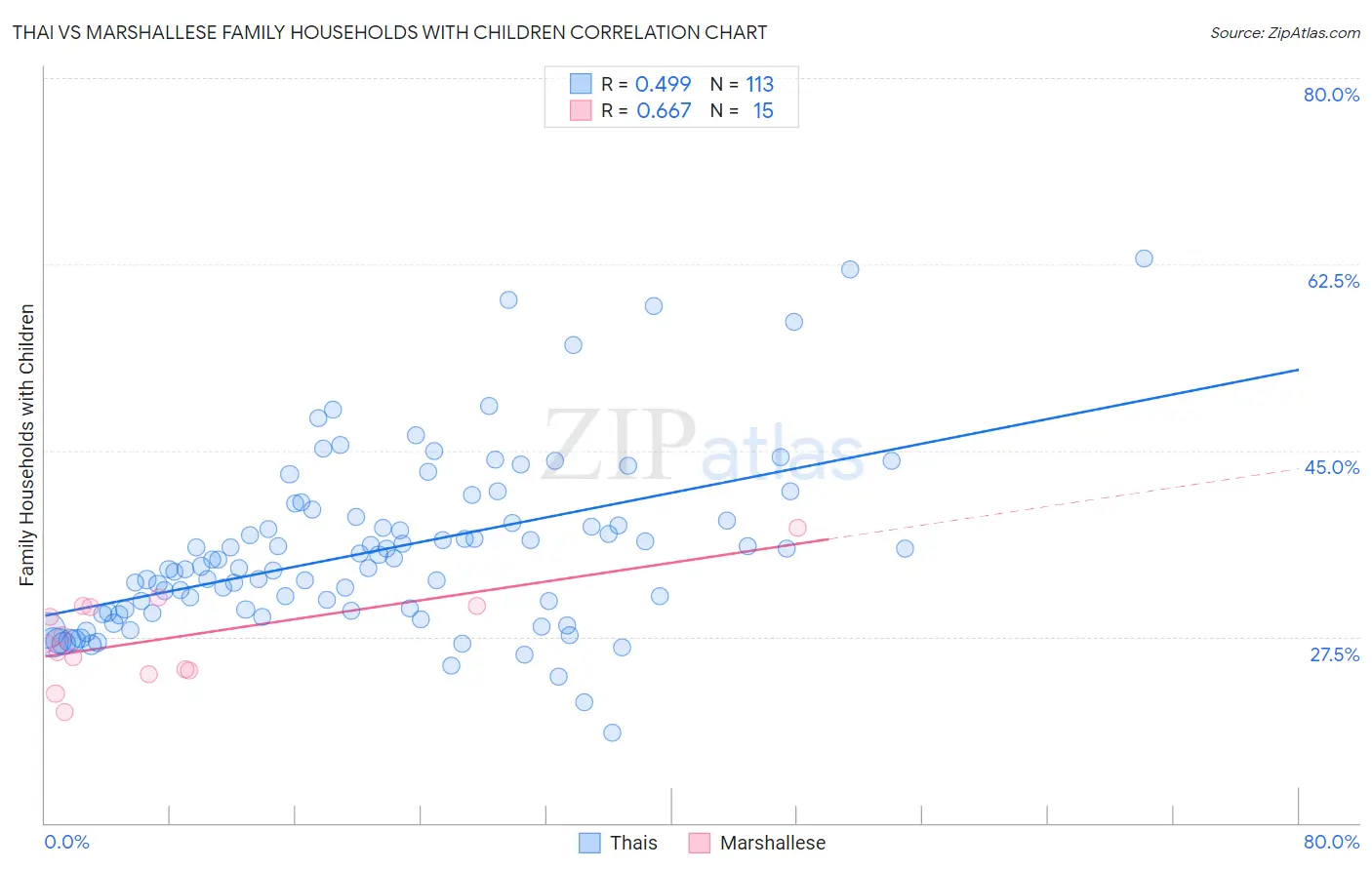Thai vs Marshallese Family Households with Children
COMPARE
Thai
Marshallese
Family Households with Children
Family Households with Children Comparison
Thais
Marshallese
30.6%
FAMILY HOUSEHOLDS WITH CHILDREN
100.0/ 100
METRIC RATING
9th/ 347
METRIC RANK
26.2%
FAMILY HOUSEHOLDS WITH CHILDREN
0.0/ 100
METRIC RATING
310th/ 347
METRIC RANK
Thai vs Marshallese Family Households with Children Correlation Chart
The statistical analysis conducted on geographies consisting of 475,181,925 people shows a moderate positive correlation between the proportion of Thais and percentage of family households with children in the United States with a correlation coefficient (R) of 0.499 and weighted average of 30.6%. Similarly, the statistical analysis conducted on geographies consisting of 14,760,991 people shows a significant positive correlation between the proportion of Marshallese and percentage of family households with children in the United States with a correlation coefficient (R) of 0.667 and weighted average of 26.2%, a difference of 16.7%.

Family Households with Children Correlation Summary
| Measurement | Thai | Marshallese |
| Minimum | 18.5% | 20.5% |
| Maximum | 63.0% | 37.7% |
| Range | 44.5% | 17.2% |
| Mean | 35.6% | 27.4% |
| Median | 34.1% | 26.9% |
| Interquartile 25% (IQ1) | 29.8% | 24.3% |
| Interquartile 75% (IQ3) | 38.6% | 30.4% |
| Interquartile Range (IQR) | 8.8% | 6.1% |
| Standard Deviation (Sample) | 8.2% | 4.3% |
| Standard Deviation (Population) | 8.2% | 4.2% |
Similar Demographics by Family Households with Children
Demographics Similar to Thais by Family Households with Children
In terms of family households with children, the demographic groups most similar to Thais are Immigrants from Fiji (30.5%, a difference of 0.32%), Nepalese (30.5%, a difference of 0.40%), Yakama (30.8%, a difference of 0.48%), Immigrants from Central America (31.0%, a difference of 1.1%), and Immigrants from Pakistan (30.2%, a difference of 1.3%).
| Demographics | Rating | Rank | Family Households with Children |
| Inupiat | 100 /100 | #2 | Exceptional 32.8% |
| Immigrants | Mexico | 100.0 /100 | #3 | Exceptional 31.6% |
| Mexicans | 100.0 /100 | #4 | Exceptional 31.4% |
| Tongans | 100.0 /100 | #5 | Exceptional 31.2% |
| Immigrants | India | 100.0 /100 | #6 | Exceptional 31.0% |
| Immigrants | Central America | 100.0 /100 | #7 | Exceptional 31.0% |
| Yakama | 100.0 /100 | #8 | Exceptional 30.8% |
| Thais | 100.0 /100 | #9 | Exceptional 30.6% |
| Immigrants | Fiji | 100.0 /100 | #10 | Exceptional 30.5% |
| Nepalese | 100.0 /100 | #11 | Exceptional 30.5% |
| Immigrants | Pakistan | 100.0 /100 | #12 | Exceptional 30.2% |
| Afghans | 100.0 /100 | #13 | Exceptional 30.2% |
| Bangladeshis | 100.0 /100 | #14 | Exceptional 30.1% |
| Immigrants | South Central Asia | 100.0 /100 | #15 | Exceptional 30.0% |
| Immigrants | Afghanistan | 100.0 /100 | #16 | Exceptional 30.0% |
Demographics Similar to Marshallese by Family Households with Children
In terms of family households with children, the demographic groups most similar to Marshallese are Immigrants from Somalia (26.3%, a difference of 0.050%), Colville (26.2%, a difference of 0.050%), Immigrants from Czechoslovakia (26.2%, a difference of 0.12%), Lumbee (26.3%, a difference of 0.16%), and West Indian (26.3%, a difference of 0.18%).
| Demographics | Rating | Rank | Family Households with Children |
| Immigrants | Guyana | 0.1 /100 | #303 | Tragic 26.3% |
| Immigrants | Bahamas | 0.1 /100 | #304 | Tragic 26.3% |
| Guyanese | 0.1 /100 | #305 | Tragic 26.3% |
| Bermudans | 0.1 /100 | #306 | Tragic 26.3% |
| West Indians | 0.0 /100 | #307 | Tragic 26.3% |
| Lumbee | 0.0 /100 | #308 | Tragic 26.3% |
| Immigrants | Somalia | 0.0 /100 | #309 | Tragic 26.3% |
| Marshallese | 0.0 /100 | #310 | Tragic 26.2% |
| Colville | 0.0 /100 | #311 | Tragic 26.2% |
| Immigrants | Czechoslovakia | 0.0 /100 | #312 | Tragic 26.2% |
| Cree | 0.0 /100 | #313 | Tragic 26.2% |
| French Canadians | 0.0 /100 | #314 | Tragic 26.1% |
| Immigrants | Norway | 0.0 /100 | #315 | Tragic 26.1% |
| Estonians | 0.0 /100 | #316 | Tragic 26.1% |
| Ottawa | 0.0 /100 | #317 | Tragic 26.1% |